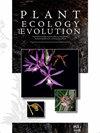Nocturnal and diurnal pollination in Copaifera coriacea, a dominant species in sand dunes of the Middle São Francisco River Basin, Northeastern Brazil
IF 1.1
4区 生物学
Q3 PLANT SCIENCES
引用次数: 0
Abstract
Background and aims – Copaifera coriacea, a species in the resin-producing clade Detarioideae (Leguminosae), is an endemic and abundant species found in sand dunes in Brazilian Caatinga domain vegetation – a Quaternary paleodesert. We investigated floral traits and aspects of pollination biology, focusing on the pollination system of C. coriacea. Material and methods – Anthesis duration, stigma receptivity, pollen viability, nectar concentration, and the presence of osmophores and pigments reflecting UV light were assessed. Floral visitors were classified as potential pollinators, occasional pollinators or thieves, based on the time and foraging behaviour and resource collected. Pollination effectiveness were assessed for potential pollinators by the detection of pollen tubes on the stigma or stylar canal by epifluorescence microscopy.Key results – The species has white and small flowers, with anthesis beginning in the dark (ca 00:30) and the flowers are completely opened approximately 3 h later, when a sweet odour is perceptible. The onset of stigma receptivity and pollen grain viability occurs only after the completion of flower opening, and a concentrated nectar is available during the day. The presence of pollen tubes confirmed the efficiency of the main insects in the transfer of pollen. Conclusion – Our result demonstrates that C. coriacea has a generalist pollination system mediated mainly by two distinct guilds of insect pollinators: moths (nocturnal, searching for nectar) and bees (diurnal, pollen collectors). This finding can provide more information about diversification in the genus Copaifera.巴西东北部São Francisco河流域中部沙丘的优势物种coriacea的夜间和日间授粉
背景与目的:Copaifera coriacea是产树脂分支Detarioideae(豆科)中的一种,是巴西Caatinga地区第四纪古沙漠植被的特有物种。研究了芫荽花的花学性状和传粉生物学,重点研究了芫荽花的传粉系统。材料和方法-评估了花期、柱头接受性、花粉活力、花蜜浓度以及反射紫外线的渗透孔和色素的存在。根据访花者的时间、采食行为和资源收集情况,将访花者分为潜在传粉者、偶尔传粉者和偷窃者。利用荧光显微镜检测柱头或花柱管上的花粉管,评价潜在传粉者的传粉效果。主要结果-该物种有白色和小的花,在黑暗中开始开花(大约00:30),花在大约3小时后完全开放,这时可以闻到甜味。柱头接受性和花粉粒活力只有在开花完成后才开始,白天有浓缩的花蜜。花粉管的存在证实了主要昆虫在花粉传递方面的效率。结论:本研究结果表明,马齿苋具有一个广泛的传粉系统,主要由两种不同的昆虫传粉者介导:飞蛾(夜间,寻找花蜜)和蜜蜂(白天,收集花粉)。这一发现可以提供更多关于Copaifera属植物多样性的信息。
本文章由计算机程序翻译,如有差异,请以英文原文为准。
求助全文
约1分钟内获得全文
求助全文
来源期刊

Plant Ecology and Evolution
PLANT SCIENCES-
CiteScore
2.20
自引率
9.10%
发文量
27
审稿时长
>12 weeks
期刊介绍:
Plant Ecology and Evolution is an international peer-reviewed journal devoted to ecology, phylogenetics and systematics of all ‘plant’ groups in the traditional sense (including algae, cyanobacteria, fungi, myxomycetes), also covering related fields.
The journal is published by Meise Botanic Garden and the Royal Botanical Society of Belgium.
 求助内容:
求助内容: 应助结果提醒方式:
应助结果提醒方式:


